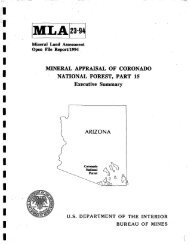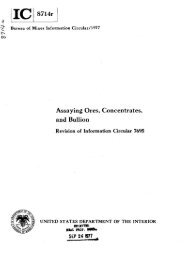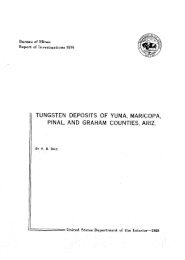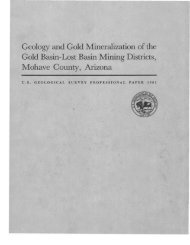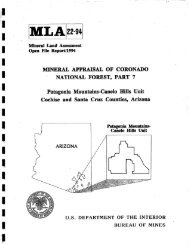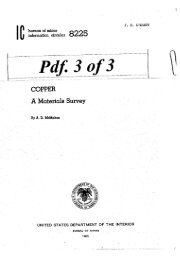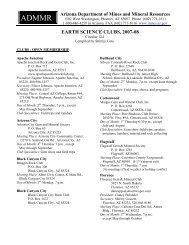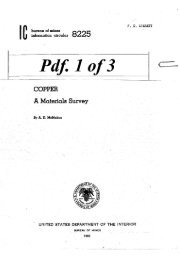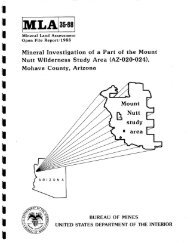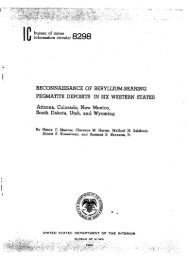here - State of Arizona Department of Mines and Mineral Resources
here - State of Arizona Department of Mines and Mineral Resources
here - State of Arizona Department of Mines and Mineral Resources
You also want an ePaper? Increase the reach of your titles
YUMPU automatically turns print PDFs into web optimized ePapers that Google loves.
194 PRINCIPAL GOLD-PRODUCING DISTRICTS OF THE UNITED STATES<br />
were still being worked, on a fairly large scale, in<br />
the early 1950's by the Round Mountain Gold<br />
Dredging Corp. Their operations were suspended<br />
during 1953-57, but were resumed in 1958; in<br />
1958-59 this company was the largest gold producer<br />
in Nevada.<br />
Ferguson <strong>and</strong> Cathcart (1954) estimated the total<br />
gold production <strong>of</strong> the district to be worth $8 million,<br />
<strong>of</strong> which about 15 or 20 percent was from<br />
placers <strong>and</strong> the remainder was from lodes. This<br />
would amount to about 329,000 ounces <strong>of</strong> lode gold<br />
<strong>and</strong> 58,200 ounces <strong>of</strong> placer gold. Most <strong>of</strong> the district's<br />
production during 1950-59 was combined<br />
with reports from other districts, but it was probably<br />
about 150,000 ounces. Total gold production<br />
for the district through 1959 was about 537,000<br />
ounces.<br />
The oldest rocks in the area are lower Paleozoic<br />
limestone, jasper, <strong>and</strong> dark slaty schist (Ferguson,<br />
1922, p. 386-398). These rocks are intensely folded<br />
<strong>and</strong> were intruded during Cretaceous time by bodies<br />
<strong>of</strong> granitic magma. Tertiary rocks, chiefly porphyritic<br />
rhyolite (Oddie Rhyolite) <strong>and</strong> lake beds <strong>of</strong> the<br />
Siebert Fonnation, overlie the folded Paleozoic<br />
rocks.<br />
T<strong>here</strong> were two periods <strong>of</strong> mineralization. The<br />
first occurred just after the granitic intrusions <strong>and</strong><br />
is characterized by huebnerite-bearing veins in the<br />
granite. The 8eaond period <strong>of</strong> mineralization is <strong>of</strong><br />
Tertiary age <strong>and</strong> resulted in the fonnation <strong>of</strong> epithermal<br />
gold-bearing quartz veins in the rhyolite.<br />
The mineralogy <strong>of</strong> these veins is relatively simple<br />
<strong>and</strong> consists <strong>of</strong> gold, auriferous pyrite, <strong>and</strong> sparse<br />
realgar in a gangue <strong>of</strong> drusy <strong>and</strong> comb quartz,<br />
adularia, <strong>and</strong> alunite. After the primary gold mineralization,<br />
additional fissures were fonned in which<br />
iron <strong>and</strong> manganese oxides <strong>and</strong> gold were deposited<br />
by supergene solutions. The gold in these later<br />
fractures was probably derived from the primary<br />
auriferous pyrite.<br />
TONOPAH DISTRICT<br />
This district is in the southern San Antonio<br />
Mountains near Tonopah, the county seat <strong>of</strong> Nye<br />
County <strong>and</strong> the largest town in the county.<br />
Tonopah was predominantly a silver district, but<br />
it also yielded large amounts <strong>of</strong> gold. The first<br />
claims were staked in 1900, <strong>and</strong> by 1901 t<strong>here</strong> was<br />
vigorous activity which lasted until the late 1940's;<br />
t<strong>here</strong>after, production declined. The principal companies<br />
were the Tonopah Mining, the Tonopah Belmont<br />
Development, <strong>and</strong> the Tonopah Extension<br />
(Kral, 1951, p. 171).<br />
Lincoln (1923, p. 186) listed the gold production<br />
<strong>of</strong> Tonopah from 1901 through 1921 as $30,360,903<br />
(about 1,473,830 ounces). From 1901 throug"t 1959,<br />
a total <strong>of</strong> 1,880,000 ounces <strong>of</strong> gold was pnduced.<br />
The rocks exposed in the Tonopah district are<br />
all <strong>of</strong> Tertiary age <strong>and</strong> consist <strong>of</strong> a series <strong>of</strong> lava<br />
flows, volcanic breccias, tuffs, <strong>and</strong> intrusives that<br />
have been somewhat displaced from their original<br />
attitudes by extensive faulting. Seven fon'1ations<br />
recognized in the district (Nolan, 1935b, p. 13) are,<br />
from oldest to youngest: the Tonopah Formation<br />
(volcanic tuffs, breccias, flows), S<strong>and</strong>grass Andesite<br />
(dark lavas interlayered with the Tonopah<br />
Fonnation), Mizpah Trachyte (2,000-foot-thick<br />
flows <strong>and</strong> breccias overlying the Tonopah), Extension<br />
Breccia (tabular intrusive mass in west half<br />
<strong>of</strong> district), West End Rhyolite (sills as much as<br />
600 feet thick that intrude the older formr,tions),<br />
Fraction Breccia Member <strong>of</strong> Esmeralda Formation<br />
(volcanic breccia unconformably overlying ore<br />
bodies), <strong>and</strong> postore rhyolite (dikes <strong>and</strong> lenticular<br />
bodies that intrude the older rocks). Numerous<br />
faults cut the Tertiary rocks, <strong>and</strong> Nolan (1935b,<br />
p. 28-39) divided them into three general groups:<br />
the Halifax fault zone which strikes generally<br />
northward; the Tonopah, a compound fault that in<br />
cross section has a trace that is convex upward;<br />
<strong>and</strong> the youngest group which includes a fault<br />
which strikes northwest, another which strikes<br />
northeast, <strong>and</strong> a third which strikes north <strong>and</strong> dips<br />
west.<br />
The ore bodies are replacement veins in faults or<br />
fractures (Nolan, 1935b, p. 40-49). The Tonopah<br />
fault is believed to have exerted a major control<br />
on the movement <strong>of</strong> mineralizing solutions. Ore<br />
bodies are found in all three groups <strong>of</strong> faults, but<br />
the Tonopah <strong>and</strong> Halifax seem to be more heavily<br />
mineralized. Hypogene ore contains electrum. argentite,<br />
polybasite, <strong>and</strong> pyrargyrite in a gar?:,ue <strong>of</strong><br />
quartz, pink carbonate, barite, <strong>and</strong> altere'l wallrocks.<br />
T<strong>here</strong> has been some supergene enrichment<br />
locally, but the hypogene ore has been m'lst important.<br />
TYBO DISTRICT<br />
The Tybo (Hot Creek, Keystone, Empire) district<br />
is in northeastern Nye County, in the Hot; Creek<br />
Range, 65 miles northeast <strong>of</strong> Tonopah <strong>and</strong> about<br />
100 miles southwest <strong>of</strong> Ely (lat 38°23' :roT., long<br />
116°23' E.). In the district, gold is a byproduct <strong>of</strong><br />
ores mined primarily for their lead <strong>and</strong> silYer content.<br />
The first mineral discoveries were made in<br />
1865, <strong>and</strong> the town <strong>of</strong> Hot Creek was the population<br />
center during the early days (Kral, 1951, p. 189).<br />
The district prospered from the rich near-surface



